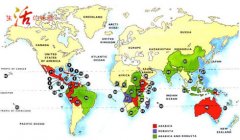Coffee Knowledge Lists
-
The Cultural History of Fine Coffee the Origin of Ice drop Coffee

Ice drop coffee originated in Europe, because the coffee distiller was invented by the Dutch, so some people call it espresso or water drop coffee. Condensation natural osmotic water pressure, up to more than 8 hours, bit by bit extraction. The taste of coffee will change with the degree of coffee roasting, water volume, water temperature, droplet speed, coffee grinding fineness and other factors. Ice drop coffee
2014-11-22 Coffee culture coffee origin ice drop coffee -
Boutique coffee common sense the picking process of coffee beans

Coffee trees usually blossom in 3-4 years, about 2-3 months a year, and their appearance and smell are similar to those of jasmine. when they bloom, they grow in clusters on the branches and bloom for 3-5 days. After the flowers bloom, they bear small green fruits, which ripen and turn red into ripe fruits that can be picked after a few months. The skin of ripe fruit is red. Because its shape and color are similar to cherries, ripe coffee fruit is called coffee cherry in many places.
2014-11-22 Coffee knowledge boutique coffee knowledge coffee bean picking -
Brilliant Coffee utensils about Bone porcelain Cups

We drink coffee during coffee training or on a daily basis, and sometimes we come into contact with bone china cups. So what's the matter with the bone china cup? How much do you know about bone porcelain cups? The composition of the bone porcelain cup is made of 25% bone powder and 75% high-grade porcelain clay, which is characterized by light texture (weight), strong light transmittance, soft color and high density (fragile, easy to clean) and high temperature resistance (good thermal insulation). The method of discrimination when selecting is
2014-11-22 Coffee knowledge boutique coffee coffee utensils bone porcelain cups -
Effects of various substances in Water on Coffee

Choosing the right water can make coffee completely release its unique flavor, and every chemical in the water may react with coffee beans, thus affecting its taste and flavor. understanding the possible effects of some common chemicals in water on the taste of coffee is helpful for us to choose the right water. Too much magnesium will make the coffee look lighter. Lead
2014-11-22 Coffee knowledge coffee common sense water quality coffee flavor influence -
General knowledge of Fine Coffee beans

All kinds of coffee beans have different tastes, but they are almost the same size, but the elephant bean is different, it is three times or more than other coffee beans. The taxonomic name of elephant bean is Maragogipe (also known as Maragogype), which comes from Malagogippe County, Bahia State, Brazil. The taxonomic status of elephant beans was first established in the county in 1870. Arabica coffee
2014-11-22 Coffee knowledge boutique coffee beans like beans -
Coffee origin introduction to Papua New Guinea Coffee

In recent years, Papua New Guinea Coffee began to wash Arabica beans with its own unique high-quality water, representing Asia to enter the ranks of the world specialty coffee. The coffee style of Papua New Guinea has the characteristics of full particles, moderate acidity and mellow taste. Papua New Guinea is an island country in Oceania. Papua means curly hair in Malay.
2014-11-22 Coffee knowledge coffee origin Papua New Guinea coffee -
High-quality coffee like beans in raw beans of coffee

All kinds of coffee beans have different tastes, but they are almost the same size, but the elephant bean is different, it is three times or more than other coffee beans. The taxonomic name of elephant bean is Maragogipe, which comes from Malagogippe County, Bahia State, Brazil. The taxonomic status of elephant beans was first established in the county in 1870. A hybrid variety of Arabica coffee.
2014-11-22 Coffee knowledge boutique coffee science coffee raw beans elephant beans -
Coffee knowledge the concept and principle of Coffee Grinding

The operation of crushing roasted coffee beans is called grinding. The ideal time to grind coffee is to grind it before cooking. Because ground coffee is easy to oxidize and lose its flavor, especially without proper storage, coffee powder is also easy to change flavor, so it is naturally impossible to cook mellow coffee. Some people are afraid of trouble or don't want to buy more bean grinders. They usually buy coffee at home.
2014-11-22 Coffee knowledge coffee grinding concepts principles -
Tasting coffee, tasting Turkish coffee.

After learning to make Turkish coffee, we also need to learn to drink Turkish coffee to better taste the exotic flavor. Preparing cold water to gargle Turkish coffee is a kind of coffee with unusually thick and mellow taste, because it generally uses deep-roasted coffee beans and has not been filtered, so it is very mellow and tastes like chocolate, mixed with a little.
2014-11-22 Coffee knowledge tasting coffee Turkish coffee -
Detailed analysis of coffee bean ingredients

Volatile substances: Volatile substances are the main source of coffee flavor and are especially important for coffee quality. There are many kinds of volatile compounds in coffee, and their existence will affect the aroma quality of coffee. The main source is derived from non-volatile substances from raw beans, which are broken off or reacted during roasting. Thermal decomposition, other reactions, or interactions between components, e.g. sugar
2014-11-22 Coffee knowledge Fine coffee science Coffee bean ingredients -
The history of coffee pots and presses

French pressure pot frenchpress, as early as 30 years ago, Alfred Pitt, the founder of Pitt Coffee, a famous roaster in the Berkeley district of the West Bank of the United States, made every effort to promote this convenient, fast, and effective way of brewing. Pitt believes that only the use of French pressure can perfectly demonstrate the charming and mellow flavor of deep-roasted coffee. The piston pot method is called the pressure method in France and the United States in the United States.
2014-11-22 Coffee knowledge coffee pot French kettle history -
Puerto Rican Coffee, the producer of boutique coffee, smells in the Caribbean

Sometimes the tongue is a key that opens the space between memory and imagination. For example, about the taste of the Caribbean, it starts with the cup of Puerto Rican coffee in the leisure afternoon. Take a deep breath and the aroma of coffee reaches the chest through your throat. In recent years, the number of coffee enthusiasts has increased sharply. Since coffee landed in Taiwan in 1884, the development of coffee in China has experienced
2014-11-22 Coffee knowledge boutique coffee coffee production Puerto Rican coffee -
The method of taking beans in the sun for the primary processing of coffee beans

Tanning is a traditional method for the initial processing of coffee beans, and at present, almost all coffee-growing countries such as Ethiopia and Yemen still use solarization to treat raw beans. Sun treatment will first identify sunken beans in the sink, that is, ripe or half-ripe beans are spread in the drying farm for natural drying. The specific time depends on the local climatic conditions, which usually takes two to four weeks.
2014-11-22 Coffee knowledge coffee bean processing solarization -
Water washing method for the primary processing of coffee beans

Washing is the most popular and widely used method of raw bean treatment at present, and most of the boutique coffee beans will choose the washing method. In South America, all countries except Brazil choose to wash raw beans. Washing is the most scientific and technological method among all the treatment methods, and multiple screening is used to ensure the uniformity and stability of coffee bean quality. First of all, still
2014-11-22 Coffee knowledge coffee bean processing washing method -
Coffee Roasting Equipment

Coffee is popular mainly because of the aroma formed after roasting and the taste when drinking. Coffee beans themselves do not have any special taste, roasting will be a thorough transformation and reorganization of the substances inside the beans, forming a new structure, thus bringing out the flavor of coffee, and coffee roasting is also a coffee knowledge that baristas need to understand. Baking tools Baking machine, sub
2014-11-22 Coffee knowledge coffee knowledge coffee roasters -
The knowledge of picking Coffee trees in High-quality Coffee

Coffee trees usually blossom in 3-4 years, about 2-3 months a year, and their appearance and smell are similar to those of jasmine. when they bloom, they grow in clusters on the branches and bloom for 3-5 days. After the flowers bloom, they bear small green fruits, which ripen and turn red into ripe fruits that can be picked after a few months. The skin of ripe fruit is red. Because its shape and color are similar to cherries, ripe coffee fruit is called coffee cherry in many places.
2014-11-22 Coffee knowledge boutique caffeine coffee tree picking -
Coffee brilliant common sense and wild Mediterranean coffee

Mediterranean coffee is a blend of coffee, chocolate syrup and various spices. The mixed spices are like the multicultural features of the Mediterranean, with the wild nomads of northern Africa, the long history of Arabs in West Asia, and the sunny character of southern Europeans. So, if you want to create a special atmosphere on a special day, Mediterranean coffee is you.
2014-11-22 Coffee knowledge coffee common sense Mediterranean coffee -
Coffee Culture training knowledge Chapter Coffee History

In 1000 there was a doctor in Bukhara, and the philosopher was the first to record the therapeutic effects of coffee. The application of 1470-1500 coffee spread to Mecca and Masterna. 1517 brought coffee to Constantinople after conquering Egypt. The first coffee shop in Costantinople opened in 1554. 1570-80 the order of religious institutions in Costantinople
2014-11-22 Coffee knowledge coffee culture coffee history -
Analysis of Acid components in Coffee

The acidity of coffee is usually considered to be related to the quality of coffee. Acidity is typical of high-value coffee in Central America and East Africa. Excessive sour taste is considered to be the disadvantage of coffee. Acidity is related to growing at very high altitudes and mineral-rich volcanic soils. The acidity of washed beans is higher than that of sun-dried beans. For example, the concentration of sun-dried beans is heavier than that of washed beans, because the concentration obscures the acid of coffee.
2014-11-22 Coffee knowledge coffee knowledge caffeic acid -
General knowledge of boutique coffee beans map of global coffee producing areas

Coffee trees grow in tropical or subtropical agricultural gardens centered around the equator and called coffee belts. Most of the coffee production is between the Tropic of Cancer, 25 degrees north of the tropical or subtropical equator and 30 degrees south of the equator. An area with an annual average temperature of 16-25 degrees Celsius, no Frosts Descent and rainfall of 1600-2000 mm.
2014-11-22 Coffee knowledge boutique coffee beans coffee common sense coffee origin
